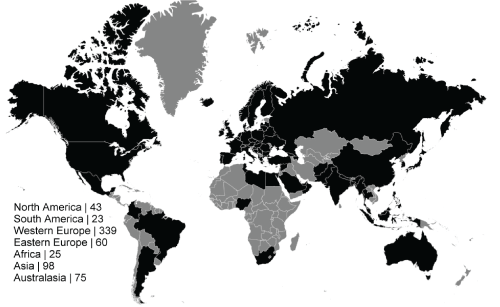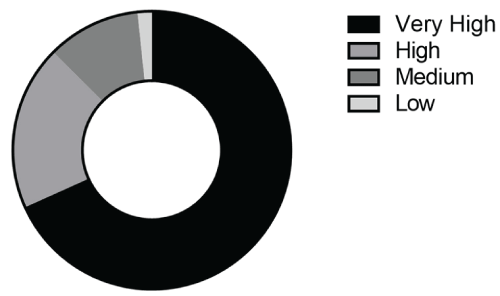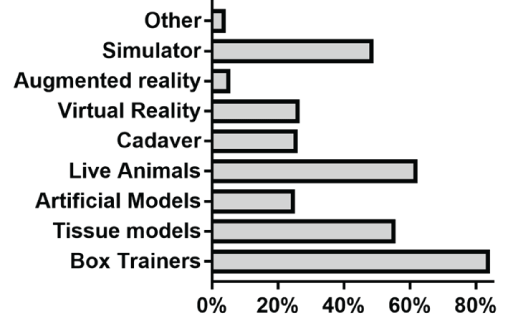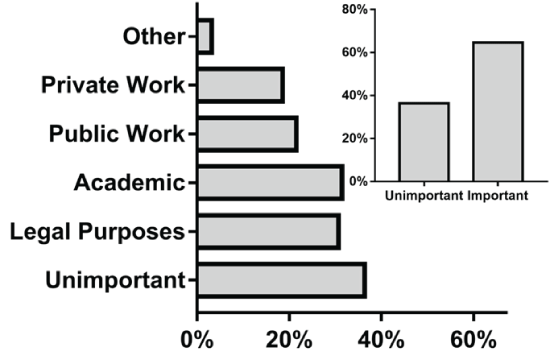
Figure 1: Map depicting the countries from which responses were received with continent wise segregation. Black are countries from which a response was received.

Sandeep Ganni1,2,3* Sanne MBI Botden4 Benjamin F Hamilton5 Arjun S Bedi6 Davide Lomanto7 Bhaskara Rao G2 Jack J Jakimowicz1,3
1Delft University of Technology, Medisign, Industrial Design Engineering, Delft, The Netherlands*Corresponding author: Sandeep Ganni, Research and Education, Catharina Hospital, Michelangelolaan 2, 5653 EJ Eindhoven, The Netherlands, Tel: +31647749121; E-mail: s.ganni@tudelft.nl
Objective: The aim of this study is to understand the current state of training practices and evaluation in laparoscopic surgery in a global context.
Design: An open-ended three part questionnaire was designed to gather the opinions about the current state of, adequacy of, and the need for a standard in laparoscopic surgical training.
Participants: Members of the European Association for Endoscopic Surgery (EAES), Endoscopic and Laparoscopic Surgeons of Asia (ELSA) and Association of Surgeons of India (ASI) were asked to participate in the survey.
Results: Of the 663 responses received, 83.6% were surgeons (64.6% in a teaching position) and 12.6% were surgical residents in training. Most respondents (75.4%) had performed over 200 laparoscopic procedures. Most (72.1%) training programs were approved/endorsed by local surgical associations or government health authorities and of the courses taught by surgical associations the majority had certified trainers (71.1%). In lower Human Development Index (HDI) countries significantly less courses are taught by certified trainers (68.2% versus 54.6%, p<0.001). Only 26.8% stated that their respective government health authorities participated in the certification of laparoscopic surgery; certification was considered important by 63.6%. However, only 17.8% of government health authorities contributed to ensure the quality of laparoscopic training, mostly in very high HDI. Only 3.3% of respondents considered the laparoscopic training and education in their country to be optimal and 51.9% rated it insufficient. Most respondents (86.3%) stated that there is a need for the standardization of laparoscopic training and 88.3% stated that standardization of laparoscopic training is important.
Conclusion: Regardless of demographic and experience factors, there was a general consensus that that there is a need for standardisation in mandatory training of laparoscopic surgical skills, although currently not obligatory in most countries.
Training; MAS; Education; Simulation; Curricula; Laparoscopic surgery
Minimal-access surgery (MAS) has revolutionized the field of surgery over the past few decades; it is now considered to be the gold-standard for many surgical procedures, due to the numerous benefits it offers to patients [1-3]. Laparoscopic surgery is more complex than open surgery and requires a new set of skills that are different from conventional surgery. The surgeon has to become proficient in handling the new instruments, the considerable loss of haptic feedback, dealing with the counter-intuitive manipulation of the instruments, eye-hand coordination and the twodimensional representation of the three-dimensional operating field [4-6].
Multiple models have been developed to train laparoscopic skills via simulation, including box trainers, animal models, virtual reality (VR) and augmented reality (AR) simulators [7-10]. The skills acquired by using simulator training have been proven by numerous studies, which show an effective transfer to the operating theatre [11-14]. However, despite this strong evidence that proves the efficacy of training, several reports state the underutilization of simulation and lack of integration within the standard surgical residency training programs [15-17]. In addition, Chang et al. [18], report that simulation based training curricula should be a mandatory part of the residency curricula.
With the implementation of restrictive working hours in both Europe and North America, surgical residents have reduced laparoscopic surgery exposure. This has been shown to reduce their experience and surgical skills [19-21]. Which creates an even greater need for an obligatory structured training curriculum, to ensure the quality of all laparoscopic surgical procedures globally. One of the challenges in implementing novel training curricula are the different attitudes and perceptions towards training among the surgical community including surgeons, residents, health authorities and the surgical industry [22]. Therefore, not only the availability of training resources, but also the initiatives of local and national health authorities and the surgical industry play an important role in delivering standard training practices [23,24].
The objective of this study was to address the influencing factors on laparoscopic training and to determine the current training practices in laparoscopic surgery globally. Also, the opinion on the quality of the current training and need for standardisation was assessed.
This study was designed to evaluate the opinions of experienced laparoscopic surgeons and surgical residents, who expressed an interest in laparoscopic techniques, regarding the current state of training and standardization of laparoscopic training.
All members of the European Association for Endoscopic Surgeons (EAES), Endoscopic and Laparoscopic Surgeons of Asia (ELSA) and The Association of Surgeons of India (ASI) were contacted by email to complete the questionnaire. The members included both experienced surgeons and inexperienced surgical residents from around the world and there was a 10.1% response rate. They were asked to complete the questionnaire, with a reminder email sent two weeks after the initial email. The participants were allotted to two groups based on their experience (more than 200 laparoscopic procedures or less than 200 laparoscopic procedures). The participants asked were from 73 countries, which were also divided in groups using the Human Development Index (HDI) ranking, because both developed and developing countries were included in this study. The countries were ranked Higher HDI and Lower HDI based on the United Nations Development Programme ranking list [25]. The first fifty countries in the list were considered as Very High and High HDI, whereas the remainders were considered Medium and Low HDI countries.
The questionnaire was designed to address demographic differences in perspectives depending on country, grouped by Human Development Index; surgical experience (surgeon or resident and number of procedures performed) and gender. The details of current training practices in their respective countries were evaluated along with their facilitation and implementation. The questionnaire ended with a statement on the need for standardisation for laparoscopic training and an open-ended question for general remarks.
All data were processed, coded and analysed using SPSS (Version 22, IBM Corp.). Because the data are nonparametric, the Mann-Whitney U and Chi-square tests were conducted to determine the statistical differences between the responses to individual questions. A p-value of <0.05 was considered a statistically significant difference. Where percentages sum to a total above 100% this is because several questions were multiple-choice and respondents responded with more than one answer. Such percentages are indicated by a+.
A total of 663 responses were obtained from 73 different countries around the world (Figure 1). The countries were divided in two groups based on their Human Development Indicators ranking, in which the first group had a Very High HDI (developed country, 49 countries, n= 460 participants), and the remaining were in the second group, those countries with High, Medium or Low HDI (26 countries, n=202 participants) (Figure 2). Chi-squared tests between the Very High HDI and Lower HDI groups for questions deemed crucial have been calculated and are shown for completeness in Table 1.
| Question | Lower HDI Group (%) | Very High HDI Group (%) | Pearson Chi- Square p-value | |
| 1 | Indicate your experience level | |||
| Resident in training | 9.9 | 13.9 | <0.001* | |
| Surgeon | 80.3 | 85.2 | ||
| Other | 9.9 | 0.9 | ||
| 2 | Training of MAS in your country is | |||
| Courses as part of residency curriculum (obligatory) | 45.3 | 47.1 | 0.672 | |
| Through special courses (non-obligatory) | 66.5 | 54.2 | 0.003* | |
| Other | 3.9 | 3.0 | 0.536 | |
| 3 | Which type of courses is organized? | |||
| Mixed | 82.6 | 85.6 | 0.446 | |
| Hands-on | 13.4 | 9.8 | ||
| Theoretical | 4.1 | 4.6 | ||
| 4 | What is the level of the courses organized? | |||
| Basic | 28.6 | 13.5 | <0.001* | |
| Advanced | 8.4 | 10.1 | 0.484 | |
| Both | 58.1 | 63.7 | 0.176 | |
| Speciality | 26.6 | 29.7 | 0.419 | |
| Other | 3.0 | 2.8 | 0.909 | |
| 5 | Which type of training do the courses involve? | |||
| Box Trainers | 74.4 | 65.8 | 0.028* | |
| Tissue Models | 44.8 | 44.7 | 0.982 | |
| Artificial models | 19.2 | 20.2 | 0.765 | |
| Live Animals | 53.7 | 48.4 | 0.207 | |
| Cadaver training | 13.8 | 23.9 | 0.003* | |
| VR training | 18.7 | 22.4 | 0.289 | |
| Augmented reality training | 4.4 | 3.9 | 0.734 | |
| Simulator | 38.4 | 39.1 | 0.861 | |
| 6 | Are the trainers in the courses certified? | |||
| Yes | 68.2 | 54.6 | <0.001* | |
| No | 17.1 | 34.3 | ||
| Yes by whom | 14.7 | 10.9 | ||
| 7 | Does your country require certification in Laparoscopic surgery? | |||
| Yes | 48.8 | 11.2 | <0.001* | |
| No | 42.5 | 87.1 | ||
| Yes with why | 8.8 | 1.7 | ||
| 8 | Do you think training and education for laparoscopic surgery in your country is currently | |||
| Insufficient | 65.0 | 45.5 | <0.001* | |
| Sufficient | 13.8 | 24.5 | ||
| Adequate | 16.9 | 27.4 | ||
| Optimal | 4.4 | 56.3 | ||
| 9 | Do you think the need for standardisation in laparoscopic surgical training exists? |
|||
| Yes | 87.6 | 85.5 | 0.573 | |
| No | 10.6 | 13.3 | ||
| Yes with why | 1.9 | 1.2 |
Table 1: Chi-squared tests between the High HDI and Lower HDI groups for questions deemed crucial in the survey.

Figure 1: Map depicting the countries from which responses were received with continent wise segregation. Black are countries from which a response was received.

Figure 2: The distribution of HDI between the participants in the survey.
Of all participants, 83.6% were surgeons and 12.6% were surgical residents in training (n=641). Most participants were male (87.3%), with no significant different between the HDI groups or surgeons/residents. Of the surgeons, 64.6%+ were also in a teaching position, while the remainder performed the procedures themselves.
When dividing the participants based on laparoscopic experience, the majority (75.4%) performed more than 200 laparoscopic procedures and was marked as experienced surgeons for this study. The remainder was marked as less experienced.
The vast majority of training courses are organized by either teaching hospitals (46.9%+), University hospitals (57.8%+) or surgical associations (66.2%+). However, 40.9%+ of respondents suggested that courses are organized by the surgical industry. Most of the training programs were approved/endorsed by local surgical associations or government health authorities (72.1%). Most of the courses taught by surgical associations had certified trainers (71.1%). However, there were significantly less courses taught by certified trainers in lower HDI countries (68.2%+ versus 54.6%+, p<0.001). Although 69.3%+ responded that there are special courses for laparoscopic training, only 56.4%+ stated that is was part of the residency curriculum.
The majority of the responses stated that the courses used both theory (instructions and lectures) and hands-on training (84.7%), while 10.7% had only hands-on and 4.6% only theoretical courses available in their country. The majority of training modalities used during the courses were box trainers (83.6%+), live animals (61.6%+), tissue models (54.9%+) and simulator training (48.3%+) (Figure 3). The majority, of the courses were multimodal (78.9%+), of which most often both the box trainer and VR/ AR simulators were used (45.2%+). When live animals were used, this was most often a unimodal training course (64%+).

Figure 3: Different modalities used in education and training MAS.
Most courses included indicator procedures as a base for the training, for which laparoscopic cholecystectomy was used most often (93.0%+), followed by appendectomy (75.2%+). These procedures were included as procedural tasks in 75.6%+ of the courses, with the remainder only using component tasks. Live surgery demonstrations featured in 80.0% of the courses, however, in countries with a lower HDI rating, a significantly lower proportion of courses had live surgery demonstrations (U=-3.713, p<0.001). In 75.2% of the participants both basic and advanced courses were provided, which was mainly in the very high HDI countries (28.6% versus 13.5%, p<0.001).
One third responded that there was no assessment of the course, or only partly and particularly the knowledge component was not assessed (30%). The assessment tools used in the courses were validated tools such as Competency Assessment Tool (CAT), Observational Clinical Human Reliability Index (OCHRA), McGill Inanimate System for Training and Evaluation of Laparoscopic Skills (MISTELS) and (Objective Structured assessment of technical skill) OSATS. Other responses on the assessment were “occasionally theoretical examination”, “there is no special system of evaluation” and “individual interview”.
Only 26.8% stated that their respective government health authorities participated in the certification of laparoscopic surgery with no difference between the HDI-grouped data with a U leading to (often significantly more than) p>0.05 in each case. In 52 of 73 countries there is currently no certification in laparoscopic surgery required during the surgical training. Furthermore, certification was considered important by 63.6%, with the most stated rational legal purposes (Figure 4). Only 3.3% of respondents considered the laparoscopic training and education in their country to be optimal and 51.9% considered the training insufficient.

Figure 4: Reasons for importance of certification.
The vast majority of respondents (86.3%) were of the opinion that there is a need for standardization of laparoscopic training. Experienced surgeons more often stated a need for standardization (16.7% versus 8.1% p=0.0147). On the contrary, according to the participants in only 17.8% the government health authorities contributed to ensure the quality of laparoscopic training, which was in 14 mainly Very High HDI countries (10).
Less than half of the respondents were familiar with both the Fundamentals in Laparoscopic Surgery course (FLS) (47.4%) and Laparoscopic Surgical Skills curriculum (LSS) (45.33%) in their country. However, still 88.3% stated that standardization of laparoscopic training is important.
Discussion
This study evaluates the current laparoscopic training and certification of 73 countries in both developed and developing countries. While similar studies have been conducted to assess the same areas, the scope of this study is wider, because it goes beyond the limitations of a country- or continent-specific study [26-29]. With 663 participants, this large sample size represented both experienced and inexperienced laparoscopic surgeons and surgical residents from countries ranging from a very high HDI to low HDI. The overall high level of experience in both practice and teaching benefits the results of this study. However, the opinions of the experienced surgeons were not significantly different from the results of the less experienced responders.
A review by Pellegrini et al. [30] shows that integration of laparoscopic skills training within the residency training programs shows marked improvement in the development and retention of skills. However, this study indicated that the majority of laparoscopic skills training are still conducted through non-obligatory courses outside the surgical residency training. Furthermore, some respondents in the current study indicated the nature of these courses as “if you choose to pay, you can do the course”, which makes the threshold for lower income surgeons and surgical residents much higher [31].
Most courses involve box trainers, tissue models, live animals, and (VR) simulator training. Often multimodality training was used and both component and procedural tasks were trained in these courses. The majority of courses contained both a theoretical and hands-on part of the training. This shows an overall international consensus in the best training practices for laparoscopic surgery. Although many courses included live surgery component, there was a significantly lower proportion of courses with live surgery in the lower HDI country group. This could be attributed to the high costs associated with the setup of a wet-lab and with anaesthetising animals [15,32].
Although several validated assessment methods were used, one third stated that there was no assessment of the courses at all. Interestingly, the majority of courses without an assessment were organized in Lower HDI countries.
The majority of participants indicated a need for standardized training curriculum even though one third of countries do not currently have certification of laparoscopic skills. Respondents were proactive in signing up to receive information on existing internationally accredited curricula such as the Fundamentals of Laparoscopic Surgery (FLS) and the Laparoscopic Surgical Skills (LSS) curriculum supports the thesis that there is a universal desire for standardisation in laparoscopic training.
Some of the limitations of this study surround its design; multiplechoice questions were asked in order that the complex range of respondents and opinions could be collated accurately; this makes some of the statistics more difficult to interpret however, it has yielded a broader overview of the data. In retrospect, some of the questions in this study could have benefited from using a Likert scale to achieve a more objective overview. Further, in order to attain a global range of responses, three organisations were used to distribute the survey. This may have resulted in a bias towards more experienced surgeons (those more likely to belong to a surgical association) but this was taken into account by separating the results for more and less experienced surgeons.
There appears to be an overall conformity in usage of methods and methodologies in training laparoscopic skills but the use of standard training curriculum, even within geographical regions and countries, is lacking. However, regardless of demographic and experience factors, there was a general consensus that there is a need for standardisation in mandatory training of laparoscopic surgical skills, although currently not obligatory in most countries. Given the state of advances and infiltration of laparoscopic surgery and allied technology in global practice and with the increasing restrictive working hours there is a need for a standard in training and evaluation of laparoscopic surgical skills.
Sandeep Ganni, Sanne M.B.I. Botden, Benjamin F. Hamilton, Arjun S. Bedi,Davide Lomanto, Bhaskara Rao G and Jack J. Jakimowicz have no conflicts of interest or financial ties to disclose. Ethical approval was granted for this study by the ethical committees of the European Association for Endoscopic Surgeons (EAES), Endoscopic and Laparoscopic Surgeons of Asia (ELSA) and The Association of Surgeons of India (ASI).
Download Provisional PDF Here
Article Type: Research Article
Citation: Ganni S, Botden SMBI, Hamilton BF, Bedi AS, Lomanto D, et al. (2017) Current State of Training and Evaluation of Laparoscopic Surgical Skills. J Surg Open Access 3(5): doi http://dx.doi. org/10.16966/2470-0991.148
Copyright: © 2017 Ganni S, et al. This is an open-access article distributed under the terms of the Creative Commons Attribution License, which permits unrestricted use, distribution, and reproduction in any medium, provided the original author and source are credited.
Publication history:
All Sci Forschen Journals are Open Access